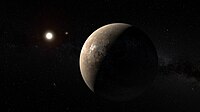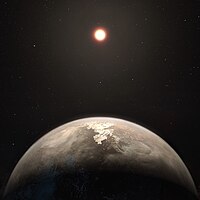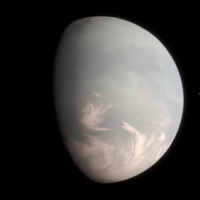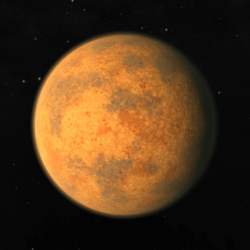Lista över närmaste terrestriska exoplanetkandidater
Den här listan är av exoplaneter inom 50 ljusår av solsystemet som kan vara terrestriska, eller jordlik. Planeter på denna lista tros att ha en stenig natur, och består inte av gas som Jupiter eller Neptunus.
Listan
| Namn | Bild (impression) | Avstånd (ljusår) | Massa (M⊕) | Halv storaxel (AE) | Moderstjärna typ | Noter |
|---|---|---|---|---|---|---|
| Proxima b |  | 4,2 | 1,27 | 0,05 | Röd dvärg | Närmsta exoplaneten, potentiellt beboelig |
| Barnards stjärna b |  | 6 | 3,23 | 0,404 | Röd dvärg | |
| Ross 128 b |  | 11 | 1,4 | 0,0496 | Röd dvärg | Potentiellt beboelig |
| Tau Ceti e | 11,7 | ≈4 | 0,538 | Sol-lik, G-klass | Obekräftad | |
| Luyten b | 12,2 | 2,89 | 0,091 | Röd dvärg | Potentiellt beboelig | |
| Kapteyn b |  | 12,83 | 7 | 0,311 | Röd dvärg | Obekräftad[1] |
| Wolf 1061b | 13,8 | 1,36 | 0,0355 | Röd dvärg | ||
| Wolf 1061c |  | 13,8 | 4,3 | 0,08427 | Röd dvärg | Potentiellt beboelig |
| Gliese 876 d |  | 15 | 6,8 | 0,021 | Röd dvärg | |
| Gliese 832 c |  | 16,16 | 5,4 | 0,162 | Röd dvärg | |
| 82 G. Eridani b | 19,71 | 2,7 | 0,1207 | Sol-lik G6 | ||
| 82 G. Eridani c | 19,71 | 2,4 | 0,2036 | Sol-lik G6 | ||
| 82 G. Eridani d | 19,71 | 4,8 | 0,3499 | Sol-lik G6 | ||
| Gliese 581 e | 20 | 1,7 | 0,029 | Röd dvärg | ||
| Gliese 581 c |  | 20 | 5,6 | 0,072 | Röd dvärg | |
| Gliese 581 d |  | 20 | 5-6 | 0,218 | Röd dvärg | Potentiellt beboelig[2] |
| Gliese 581 g |  | 20 | - | 0,13 | Röd dvärg | Potentiellt beboelig |
| HD 219134 b |  | 21 | 4,5 | 0,0387 | Huvudserien, K3V | |
| Gliese 667 Cb |  | 23,62 | 6,3 | 0,05 | Röd dvärg | |
| Gliese 667 Cc |  | 23,62 | 3,8 | 0,13 | Röd dvärg | Potentiellt beboelig |
| 61 Virginis b |  | 28 | 5,1 | 0,05 | Huvudserien G-typ | |
| HD 85512 b |  | 36 | 3,6 | 0,26 | Huvudserien, K5V | |
| Gliese 180 b | 38 | 8 | 0,103 | Röd dvärg | [3] | |
| Trappist-1b |  | 39,5 | 1,017 | 0,0115 | Röd dvärg | |
| Trappist-1c |  | 39,5 | 1,156 | 0,0158 | Röd dvärg | |
| Trappist-1d |  | 39,5 | 0,3 | 0,22 | Röd dvärg | Potentiellt beboelig |
| Trappist-1e |  | 39,5 | 0,772 | 0,29 | Röd dvärg | Potentiellt beboelig |
| Trappist-1f |  | 39,5 | 0,68 | 0,037 | Röd dvärg | Potentiellt beboelig |
| Trappist-1g |  | 39,5 | 1,34 | 0,0451 | Röd dvärg | Potentiellt beboelig |
| Trappist-1h |  | 39,5 | 0,086 | 0,063 | Röd dvärg | |
| LHS 1140b |  | 40 | 6,6 | 0,0875 | Röd dvärg | Potentiellt beboelig |
| 55 Cancri e | (c) ESA/Hubble, CC BY 4.0 | 41 | 8,6 | 0,17 | Sol-lik | |
| HD 40307 b | 42 | 4,2 | 0,047 | Huvudserien, K5V | ||
| HD 40307 c | 42 | 6,8 | 0,081 | Huvudserien, K5V | ||
| HD 40307 d | 42 | 9,2 | 0,134 | Huvudserien, K5V | ||
| HD 40307 e | 42 | 3,5 | 0,186 | Huvudserien, K5V | ||
| HD 40307 f | 42 | 5,2 | 0,247 | Huvudserien, K5V | ||
| HD 40307 g |  | 42 | 7,1 | 0,6 | Huvudserien, K5V | Potentiellt beboelig[4] |
Statistik
| Avstånd (ljusår) | Totalt | Planeter som är kända att vara i den beboeliga zonen |
|---|---|---|
| Mindre än 10 | 2 | 1 |
| 10-19 | 11 | ≤6 |
| 20-29 | 8 | 4 |
| 30-39 | 9 | 5 |
| 40-50 | 7 | 1+ |
| Totalt | 37 | 17+ |
Se även
Referenser
- ^ https://www.skyandtelescope.com/astronomy-news/kapteyn-b-habitable-zone-exoplanet-or-illusion/ | Kapteyn b: Exoplanet or Illusion? | June 9, 2015
- ^ https://www.space.com/11692-alien-planet-gliese-581d-habitable-life-debate.html | Is the Rocky Alien Planet Gliese 581d Really Habitable? | May 17, 2011
- ^ http://www.openexoplanetcatalogue.com/planet/GJ%20180%20b/
- ^ https://www.space.com/18393-alien-planet-super-earth-habitable-hd-40307g.html | 'Super-Earth' Alien Planet May Be Habitable for Life | November 8, 2012
Media som används på denna webbplats
PIA19833: Hot, Rocky World (Artist's Concept)
http://photojournal.jpl.nasa.gov/catalog/PIA19833
http://photojournal.jpl.nasa.gov/archive/PIA19833_HD219134_Zoom-qt720.mov
This artist's rendition shows one possible appearance for the planet HD 219134b, the nearest confirmed rocky exoplanet found to date outside our solar system. The planet is 1.6 times the size of Earth, and whips around its star in just three days. Scientists predict that the scorching-hot planet -- known to be rocky through measurements of its mass and size -- would have a rocky, partially molten surface with geological activity, including possibly volcanoes.
NASA's Jet Propulsion Laboratory in Pasadena, California, manages the Spitzer Space Telescope mission for NASA's Science Mission Directorate, Washington. Science operations are conducted at the Spitzer Science Center at the California Institute of Technology in Pasadena. Science operations are conducted at the Spitzer Science Center at the California Institute of Technology in Pasadena. Spacecraft operations are based at Lockheed Martin Space Systems Company, Littleton, Colorado. Data are archived at the Infrared Science Archive housed at the Infrared Processing and Analysis Center at Caltech. Caltech manages JPL for NASA.
For more information about Spitzer, visit http://spitzer.caltech.edu and http://www.nasa.gov/spitzer.Författare/Upphovsman: ESO/M. Kornmesser, Licens: CC BY 4.0
This artist’s impression shows the temperate planet Ross 128 b, with its red dwarf parent star in the background. This planet, which lies only 11 light-years from Earth, was found by a team using ESO’s unique planet-hunting HARPS instrument. The new world is now the second-closest temperate planet to be detected after Proxima b. It is also the closest planet to be discovered orbiting an inactive red dwarf star, which may increase the likelihood that this planet could potentially sustain life. Ross 128 b will be a prime target for ESO’s Extremely Large Telescope, which will be able to search for biomarkers in the planet's atmosphere.
In this artist's conception, the newly discovered planet is shown as a hot, rocky, geologically active world glowing in the deep red light of its nearby parent star, the M dwarf Gliese 876. The heat and the reddish light are among the few things about the new planet that are certain; depending on the thickness and composition of its atmosphere - if any - it could range from being a barren, cratered ball of rock like Mercury or the Moon, to being a featureless, cloud-shrouded cue-ball like Venus.
Författare/Upphovsman: ESO/spaceengine.org, Licens: CC BY 4.0
This artist’s impression shows the exoplanet LHS 1140b, which orbits a red dwarf star 40 light-years from Earth and may be the new holder of the title “best place to look for signs of life beyond the Solar System”. Using ESO’s HARPS instrument at La Silla, and other telescopes around the world, an international team of astronomers discovered this super-Earth orbiting in the habitable zone around the faint star LHS 1140. This world is a little larger and much more massive than the Earth and has likely retained most of its atmosphere.
Artist's impression of the exoplanet TRAPPIST-1e, located in the Aquarius system of TRAPPIST-1. Originally created for NASA as part of their announcement of discoveries in the TRAPPIST-1 system on 22 February 2017. According to NASA, both TRAPPIST-1e and TRAPPIST-1f are depicted as "covered in water, but with progressively larger ice caps on the night side." Screenshotted and cropped from File:PIA21468 - TRAPPIST-1 Planets - Flyaround Animation.ogg.
Artist's impression of the exoplanet TRAPPIST-1f, located in the Aquarius system of TRAPPIST-1. Originally created for NASA as part of their announcement of discoveries in the TRAPPIST-1 system on 22 February 2017. According to NASA, both TRAPPIST-1e and TRAPPIST-1f are depicted as "covered in water, but with progressively larger ice caps on the night side." Screenshotted and cropped from File:PIA21468 - TRAPPIST-1 Planets - Flyaround Animation.ogg.
Författare/Upphovsman: ESO/M. Kornmesser, Licens: CC BY 4.0
This artist’s impression shows the planet orbiting the Sun-like star HD 85512 in the southern constellation of Vela (The Sail). This planet is one of sixteen super-Earths discovered by the HARPS instrument on the 3.6-metre telescope at ESO’s La Silla Observatory. This planet is about 3.6 times as massive as the Earth and lies at the edge of the habitable zone around the star, where liquid water, and perhaps even life, could potentially exist.
Författare/Upphovsman: Radialvelocity, Licens: CC BY-SA 4.0
This is a rendering of the exoplanet GJ 832 c, made using the 3D software Blender 2.71. This deception shows GJ 832 c as a cloud-girdled greenhouse planet, with a dense atmosphere of water vapor and thick clouds obscuring the surface.
(c) ESA/Hubble, CC BY 4.0
This artist’s impression shows the super-Earth 55 Cancri e in front of its parent star. Using observations made with the NASA/ESA Hubble Space Telescope and new analytic software scientists were able to analyse the composition of its atmosphere. It was the first time this was possible for a super-Earth. 55 Cancri e is about 40 light-years away and orbits a star slightly smaller, cooler and less bright than our Sun. As the planet is so close to its parent star, one year lasts only 18 hours and temperatures on the surface are thought to reach around 2000 degrees Celsius.
Författare/Upphovsman: Kirk39, Licens: GPL
Gliese 581 g: Image taken from the free program Celestia (GNOME) showing the extrasolar planet
Författare/Upphovsman: ESO, Licens: CC BY 4.0
Artist's impression of the trio of super-Earths discovered by an European team using the HARPS spectrograph on ESO's 3.6-m telescope at La Silla, Chile, after 5 years of monitoring. The three planets, having 4.2, 6.7, and 9.4 times the mass of the Earth, orbit the star HD 40307 with periods of 4.3, 9.6, and 20.4 days, respectively.
This artist's concept illustrates a young, red dwarf star surrounded by three planets.
Författare/Upphovsman: ESO/L. Calçada, Licens: CC BY 4.0
This artist’s impression shows a sunset seen from the super-Earth Gliese 667 Cc. The brightest star in the sky is the red dwarf Gliese 667 C, which is part of a triple star system. The other two more distant stars, Gliese 667 A and B appear in the sky also to the right. Astronomers have estimated that there are tens of billions of such rocky worlds orbiting faint red dwarf stars in the Milky Way alone.
Författare/Upphovsman: ESO, Licens: CC BY 4.0
Artist's impression of the planetary system around the red dwarf Gliese 581. Using the instrument HARPS on the ESO 3.6-m telescope, astronomers have uncovered 3 planets, all of relative low-mass: 5, 8 and 15 Earth masses. The five Earth-mass planet (seen in foreground - Gliese 581 c) makes a full orbit around the star in 13 days, the other two in 5 (the blue, Neptunian-like planet - Gliese 581 b) and 84 days (the most remote one, Gliese 581 d).
Artist's impression of the exoplanet TRAPPIST-1g, located in the Aquarius system of TRAPPIST-1. Originally created for NASA as part of their announcement of discoveries in the TRAPPIST-1 system on 22 February 2017. According to NASA, as the furthest planet from the star, it is depicted as "covered in ice, similar to Jupiter's icy moon Europa." Screenshotted and cropped from File:PIA21468 - TRAPPIST-1 Planets - Flyaround Animation.ogg.
Författare/Upphovsman: ESO/M. Kornmesser, Licens: CC BY 4.0
Artist's impression of the exoplanet Proxima Centauri b shown as of a arid (but not completely water-free) rocky Super-Earth. This appearance is one of several possible outcomes of current theories regarding the development of this exoplanet, while the actual look and structure of the planet is known in no ways at this time. Proxima Centauri b is the closest exoplanet to the Sun and also the closest potentially habitable exoplanet as well. It orbits Proxima Centauri, a red dwarf with a surface temperature of 3040 K (thus hotter than light bulbs and therefore whiter, as depicted here). The Alpha Centauri binary system is shown in the background.
Författare/Upphovsman: Tyrogthekreeper (talk), Licens: CC BY-SA 3.0
Gliese 581 d, water-rich (?) rocky planet.
Författare/Upphovsman: Celestia, Licens: GPL
Artists Concept for the closest planet ( b ) to the star "61 Virginis"
Författare/Upphovsman: Ph03nix1986, Licens: CC BY-SA 4.0
Impresión artística de Kapteyn b
Artist's impression of the exoplanet TRAPPIST-1d, located in the Aquarius system of TRAPPIST-1. Originally created for NASA as part of their announcement of discoveries in the TRAPPIST-1 system on 22 February 2017. According to NASA, the planet is depicted as "rocky", and "has water only in a thin band along the terminator, dividing the day side and night side." Screenshotted and cropped from File:PIA21468 - TRAPPIST-1 Planets - Flyaround Animation.ogg.
Författare/Upphovsman: ESO/M. Kornmesser, Licens: CC BY 4.0
The nearest single star to the Sun hosts an exoplanet at least 3.2 times as massive as Earth — a so-called super-Earth. Data from a worldwide array of telescopes, including ESO’s planet-hunting HARPS instrument, have revealed this frozen, dimly lit world. The newly discovered planet is the second-closest known exoplanet to the Earth and orbits the fastest moving star in the night sky. This image shows an artist’s impression of the planet’s surface.
Artist's impression of the exoplanet TRAPPIST-1g, located in the Aquarius system of TRAPPIST-1. Originally created for NASA as part of their announcement of discoveries in the TRAPPIST-1 system on 22 February 2017. According to NASA, the planet is depicted "with an atmosphere like Neptune's, although it is still a rocky world." Screenshotted and cropped from File:PIA21468 - TRAPPIST-1 Planets - Flyaround Animation.ogg.
Författare/Upphovsman: ESO/L. Calçada, Licens: CC BY 4.0
The 6-Earth-mass exoplanet Gliese 667Cb orbits its low-mass host star at a distance equal to only 1/20th of the Earth–Sun distance. The host star Gliese 667C is a companion to two other low-mass stars, which are seen here in the distance.
(c) Tyrogthekreeper at en.wikipedia, CC BY-SA 3.0
Gliese 581 e, rocky extrasolar planet.
Artist's impression of the exoplanet TRAPPIST-1c, located in the Aquarius system of TRAPPIST-1. Originally created for NASA as part of their announcement of discoveries in the TRAPPIST-1 system on 22 February 2017. According to NASA, the planet is depicted as "a rocky, warm world with a small ice cap on the side that never faces the star." Screenshotted and cropped from File:PIA21468 - TRAPPIST-1 Planets - Flyaround Animation.ogg.
Artist's impression of the exoplanet TRAPPIST-1b, located in the Aquarius system of TRAPPIST-1. Originally created for NASA as part of their announcement of discoveries in the TRAPPIST-1 system on 22 February 2017. According to NASA, the planet was modeled after Jupiter's moon Io, "which has volcanic features due to strong gravitational tugs." Screenshotted and cropped from File:PIA21468 - TRAPPIST-1 Planets - Flyaround Animation.ogg.



























